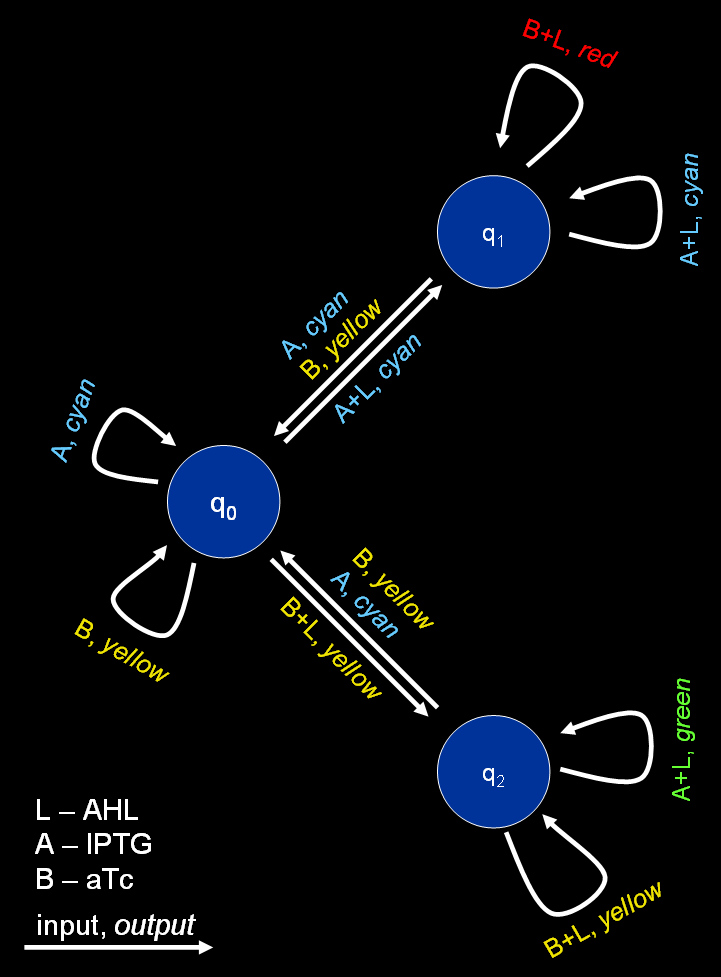ETHZ/Intro Tim
From 2007.igem.org
(→'''.:: System Explanation ::.''') |
(→'''.:: System Explanation ::.''') |
||
| Line 29: | Line 29: | ||
|} | |} | ||
The resulting automaton is shown in Fig. 1. <br /> | The resulting automaton is shown in Fig. 1. <br /> | ||
| - | In its native state (''q''<sub>0</sub>), the system reacts on the presence of either chemical A or B by fluorescing ''green'' or ''yellow'', respectively. The system itself remains in | + | In its native state (''q''<sub>0</sub>), the system reacts on the presence of either chemical A or B by fluorescing ''green'' or ''yellow'', respectively. The system itself remains in state ''q''<sub>0</sub>. Only when the input chemical is combined with a learning signal (chemical L), it changes its state either to ''q''<sub>1</sub> (in presence of chemical A) or ''q''<sub>2</sub> (in presence of chemical B). In these two states, the system is able to distinguish between changing input: while the system is in state ''q''<sub>1</sub>, the system starts fluorescing ''red'' if confronted with chemical B and vice versa when the system is in state ''q''<sub>2</sub> and confronted with chemical A (it fluoresces ''blue''). In order to maintain the states ''q''<sub>1</sub> and ''q''<sub>2</sub>, the learning signal L has to be present all the time. |
Revision as of 12:02, 18 October 2007
.:: System Explanation ::.
The proposed system is best described by a [http://en.wikipedia.org/wiki/Mealy_machine Mealy machine], a special type of [http://en.wikipedia.org/wiki/Finite_state_machine finite state machines] (FSM). Mealy machines are defined by a 6-tuple, (Q, q0, Σ, Λ, δ, Ω), with:
- Q - a set of states, for the proposed system we use three different states (q0 - not yet trained, q1 - trained to recognize chemical A, q2 - trained to recognize chemical B)
- q0 - a start state, here we assume we start in a state where the system is not yet trained
- Σ = {A+L, A, B+L, B} - an input alphabet
- Λ = {green, red, blue, yellow} - an output alphabet
- δ : Q × Σ → Q - a state transition function
- Ω : Q × Σ → Λ - an output function
In detail, the transition function δ and the output function Ω look as follows:
| inputs/states | q0 | q1 | q2 | inputs/states | q0 | q1 | q2 | |
|---|---|---|---|---|---|---|---|---|
| A+L | q1 | q1 | q1 | A+L | green | green | blue | |
| A | q0 | q0 | q0 | A | green | green | green | |
| B+L | q2 | q2 | q2 | B+L | yellow | red | yellow | |
| B | q0 | q0 | q0 | B | yellow | yellow | yellow |
The resulting automaton is shown in Fig. 1.
In its native state (q0), the system reacts on the presence of either chemical A or B by fluorescing green or yellow, respectively. The system itself remains in state q0. Only when the input chemical is combined with a learning signal (chemical L), it changes its state either to q1 (in presence of chemical A) or q2 (in presence of chemical B). In these two states, the system is able to distinguish between changing input: while the system is in state q1, the system starts fluorescing red if confronted with chemical B and vice versa when the system is in state q2 and confronted with chemical A (it fluoresces blue). In order to maintain the states q1 and q2, the learning signal L has to be present all the time.
